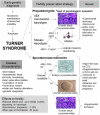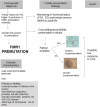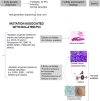Fertility preservation for genetic diseases leading to premature ovarian insufficiency (POI)
- PMID: 33495935
- PMCID: PMC8079553
- DOI: 10.1007/s10815-021-02067-7
Fertility preservation for genetic diseases leading to premature ovarian insufficiency (POI)
Abstract
Purpose: The current review aims to summarize the data available concerning the applicability of fertility preservation techniques to genetic conditions at risk of premature ovarian insufficiency (POI).
Methods: A literature review through the PubMed Database was carried out.
Results: About 10% of cases of POI is related to genetic diseases. The most frequent conditions associated with POI are Turner syndrome and fragile X pre-mutation; mutation of BRCA 1-2 genes and several other mutations and genetic syndromes have recently been highlighted, although they rarely occur. If a diagnosis is issued before POI onset, counseling on currently available fertility preservation techniques is advisable. In case of spontaneous menarche (this can occur variably depending on the mutation) established techniques like embryo or oocyte cryopreservation can be proposed, even if, in some cases, their effectiveness may be reduced by ovarian alterations connected to the mutation. Ovarian tissue cryopreservation has recently been defined as an established medical procedure for fertility preservation in young cancer patients and may be an option for prepubertal patients. However, it is still experimental in special populations with genetic diseases causing POI. New innovative experimental techniques, like in vitro maturation of immature oocytes (IVM) and vitro activation (IVA) of immature follicles on ovarian tissue, have shown limited but encouraging data and they will be probably available in the near future. For a correct risk-benefit evaluation, the following aspects should be considered: actual knowledge about the pathology-specific efficacy of the various techniques, the average age of onset of POI, the possible risks associated with the procedure in relation to the underlying pathology, the probability of spontaneous conception, as well as the health implications of a possible future pregnancy..
Conclusions: Fertility preservation techniques represent a crucial opportunity for patients with genetic risk of POI. Early diagnosis increases the chances to apply these techniques. No specific recommendations concerning fertility preservation for each genetic pathology are available, and clinicians should first counsel the patient and her relatives about known risks and benefits of the available techniques, both those established and those considered as experimental.
Keywords: BRCA; Cryopreservation; FMR1; Fertility; Genetic; Ovarian insufficiency; Turner.
Conflict of interest statement
The authors declare that they have no conflict of interest.
Figures






References
-
- European Society for Human Reproduction and Embryology (ESHRE) Guideline Group on POI. Webber L, Davies M, Anderson R, Bartlett J, Braat D, Cartwright B, Cartwright B, Cifkova R, de Muinck Keizer-Schrama S, Hogervorst E, Janse F, Liao L, Vlaisavljevic V, Zillikens C, Vermeulen N. ESHRE Guideline: management of women with premature ovarian insufficiency. Hum Reprod. 2016;31:926–937. - PubMed
-
- Nguyen HH, Milat F, Vincent A. Premature ovarian insufficiency in general practice: meeting the needs of women. Aust Fam Phys 2017. 46:360–6. - PubMed
-
- Grynberg M, Bidet M, Benard J, Poulain M, Sonigo C, Cédrin-Durnerin I, Sonigo C. Fertilitypreservation in Turner syndrome. FertilSteril. 2016;105:13–19. - PubMed
-
- American College of Obstetricians and Gynecologists (ACOG) Committee opinion no. 605: primary ovarian insufficiency in adolescents and young women. Obstet Gynecol. 2014;124:193–197. - PubMed
-
- Huhtaniemi I, Hovatta O, La Marca A, Livera G, Monniaux G, Persani L, Heddar A, Jarzabek K, Laisk-Podar T, Salumets A, Tapanainen JS, Veitia RA, Visser JA, Wieacker P, Wolczynski S, Misrahi M. Advances in the molecular pathophysiology,genetics, and treatment of primary ovarian insufficiency. Trends Endocrinol Metab. 2018;29:400–419. - PubMed
Publication types
MeSH terms
Substances
LinkOut - more resources
Full Text Sources
Other Literature Sources
Medical
Miscellaneous

